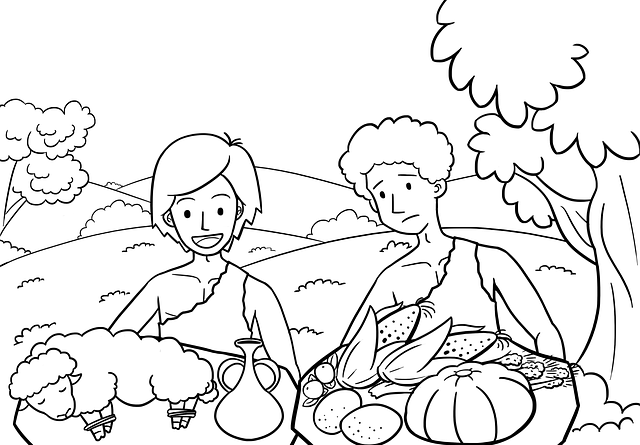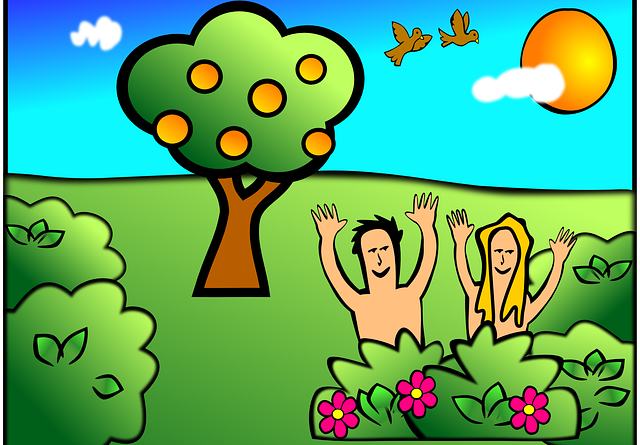Once upon a time, in a lush and vibrant garden, lived two individuals who would forever shape the destiny of mankind. Adam and Eve, the first man and woman to walk the Earth, were surrounded by breathtaking beauty, abundant fruits, and the delightful company of each other. This captivating story unveils their enchanting journey, exploring their deep bond, the temptations they faced, and the profound impact their choices had on the world as we know it. Embark on this timeless tale of love, curiosity, and the complexities of human nature.
This image is property of images.unsplash.com.
Creation of Adam and Eve
Adam’s creation
In the beginning, God created Adam, the first man, in his own image and likeness. He formed Adam from the dust of the ground and breathed life into his nostrils. This act of creation shows the special bond that God intended for humanity to have with Him. Adam was placed in the Garden of Eden, a paradise filled with beauty and abundance. He was given the role of caretaker and ruler over all the other creatures in the garden.
Eve’s creation
After realizing that it was not good for Adam to be alone, God created Eve to be his companion and helper. He took a rib from Adam’s side and formed Eve, the first woman. God brought Eve to Adam, and they became one flesh. Eve was created to share in the partnership and equality with Adam, providing him with companionship and support. Together, Adam and Eve were destined to carry out God’s plan for their lives in the Garden of Eden.
Life in the Garden of Eden
The Garden of Eden
The Garden of Eden was a paradise, a place of pure beauty and perfection. It was filled with lush vegetation, serene rivers, and delightful fruits. Every aspect of the garden was designed by God to be perfectly suited for Adam and Eve’s needs. It provided them with an environment of abundance and abundance, where they could live in harmony with nature and with God.
God’s instructions
As the caretakers of the Garden of Eden, God gave Adam and Eve specific instructions. They were free to eat from any tree in the garden, except one: the tree of the knowledge of good and evil. God warned them that if they were to eat from this tree, they would surely die. These instructions were given not to restrict Adam and Eve but to guide and protect them. It was an opportunity for them to exercise their free will and trust in God’s wisdom.
Adam’s naming of animals
Adam was given the privilege and responsibility of naming all the animals in the garden. This act highlighted his role as the caretaker and ruler of the creatures around him. It allowed Adam to interact with the animals, to discover their unique characteristics and qualities. Through this process, Adam recognized that he was alone and lacked a suitable helper. This led to the creation of Eve, further emphasizing the bond between Adam and the animals and the need for companionship.
Eve’s role
Eve, as the first woman, was created to be Adam’s partner and companion. She was uniquely designed to complement him, completing the tapestry of their relationship. Eve had her own strengths and qualities, different from Adam’s, enabling them to work together harmoniously. She contributed her wisdom, compassion, and nurturing nature to enhance their shared responsibilities in the garden. Eve’s role was crucial in fulfilling God’s plan for Adam and for humanity as a whole.
The tree of knowledge
The tree of knowledge of good and evil symbolized the choice that Adam and Eve faced. It represented the potential for them to exercise their free will and their ability to discern right from wrong. God had placed this tree in the garden as a test of obedience and trust. It was an opportunity for Adam and Eve to demonstrate their love for God by willingly choosing to obey His command. However, it also presented the temptation to go against God’s instruction and pursue knowledge beyond their current understanding.
The Fall of Man
Temptation by the serpent
One day, a crafty serpent approached Eve and questioned God’s command. The serpent cunningly suggested that eating the forbidden fruit from the tree of knowledge would make Adam and Eve like God, knowing good and evil. The serpent appealed to their desire for wisdom and independence. Although initially uncertain, Eve eventually succumbed to the serpent’s persuasive arguments and allowed herself to be swayed by the temptation.
Eve’s decision to eat the forbidden fruit
Eve, influenced by the serpent’s deceitful words, made the decision to eat the forbidden fruit from the tree of knowledge. She took a bite and then offered it to Adam, who was with her. In that moment, they both chose to disobey God’s instructions, driven by their desire for wisdom and autonomy. Their decision represented the introduction of sin into the world and marked a significant turning point in the history of humanity.
Adam’s decision to eat the forbidden fruit
Adam, despite knowing that eating from the forbidden tree was against God’s command, chose to follow Eve’s lead and also ate the forbidden fruit. Adam’s decision reinforced the significance and weight of their collective actions. Both Adam and Eve made the choice to prioritize their own desires over their obedience to God. The consequences of their decision would reverberate throughout all of creation.
Consequences of their actions
As a result of Adam and Eve’s disobedience, they became aware of their nakedness and felt shame. Their innocence was lost, replaced by the burden of sin and the separation from God. God’s perfect paradise was no longer attainable for humanity. Adam and Eve were banished from the Garden of Eden, forever changed by their decision. The consequences of their actions would impact the generations to come, shaping the course of human history.
Expulsion from Eden
God’s anger
Upon discovering the disobedience of Adam and Eve, God was filled with anger. He grieved over the choices they had made, knowing the devastating consequences it would bring upon them and their descendants. God’s anger was a reflection of His deep love for humanity and His desire for them to choose righteousness and obedience. The expulsion from the Garden of Eden was a manifestation of His righteous judgment upon their actions.
Curses and punishments
God pronounced curses upon the serpent, the woman, and the man. The serpent would crawl on its belly and eat dust, symbolizing its reduced state. The woman would experience pain in childbirth and would be in a position of subordination to her husband. The man would toil and labor for his sustenance, facing the hardships of life outside the garden. These punishments reflected the consequences of their actions and served as reminders of the broken relationship between humanity and God.
Leaving the Garden
Adam and Eve were driven out of the Garden of Eden, leaving behind the paradise they once knew. Their expulsion from the garden was a physical separation from the intimate communion they enjoyed with God. They could no longer walk and talk with Him in the same way as before. Leaving the Garden of Eden marked the beginning of their journey in a fallen world, filled with struggles, hardships, and the constant battle against sin.
Guarding the way to the tree of life
In order to prevent Adam and Eve from attaining immortality in their fallen state, God placed cherubim with a flaming sword to guard the way to the tree of life. This act showed both God’s mercy and wisdom. Immortality in their sinful condition would have meant eternal separation from God, trapped in a broken existence. It was a reminder that although their actions had severed their connection with God, His plan for redemption was already set in motion.

This image is property of images.unsplash.com.
Life Outside the Garden
Struggles and hardships
After leaving the Garden of Eden, Adam and Eve faced numerous struggles and hardships. They had to learn how to survive in a world that was no longer perfect and harmonious. They experienced pain, sickness, and death – all consequences of their disobedience. The once fruitful Earth now required hard work and labor to yield its abundance. The fallen world stood in stark contrast to the paradise they had lost, serving as a constant reminder of the choices they had made.
Work and agriculture
Outside the garden, Adam and Eve had to embrace the new reality and adapt to their surroundings. They began cultivating the land, tilling the soil, and farming to sustain themselves. The act of working the land became a necessary part of their existence. Through their toil and perseverance, they experienced the rewards of their labor, finding fulfillment and provision in the work they pursued. Despite the challenges they faced, Adam and Eve discovered the potential for growth, productivity, and meaning outside the confines of the Garden of Eden.
Cain and Abel
As Adam and Eve’s family grew, their two sons, Cain and Abel, played significant roles in their post-Eden lives. Cain, the firstborn, became a farmer, working the ground just as his father did. Abel, on the other hand, became a shepherd, tending to the animals. Both brothers brought offerings to God, but Abel’s offering was accepted, while Cain’s was rejected. This event marked the beginning of the struggles between good and evil within humanity, illustrating the consequences of sin and the importance of a heart aligned with God.
Generations and Descendants
Cain’s descendants
Cain, after killing his brother Abel in a fit of jealousy, went on to have descendants of his own. His descendants were known for their wickedness, arrogance, and disregard for God’s ways. The lineage of Cain became associated with corruption and moral decline. This served as a reminder of the consequences that can arise when one turns away from God’s path and allows sin to influence their lives.
Seth and his descendants
In contrast to Cain’s lineage, Seth, Adam and Eve’s third son, became the father of a righteous line of descendants. This line sought to honor God and walk in His ways. Seth’s descendants valued righteousness and obedience, standing as a testament to the potential for redemption and restoration. Through Seth’s lineage, the promise of a Savior was preserved, setting the stage for future generations to experience reconciliation with God.

This image is property of images.unsplash.com.
Conclusion
Lessons learned
The story of Adam and Eve holds many lessons for us. It teaches us about the consequences of disobedience, the importance of obedience and trust in God’s guidance, and the significance of our choices. Adam and Eve’s actions remind us of the fragility of the human condition and the need for constant vigilance against temptation. We are reminded of the potential for both great beauty and great brokenness within humanity—and the power of God’s grace to restore and redeem.
Spiritual interpretations
The story of Adam and Eve also holds deep spiritual meanings. It reflects our own spiritual journey, depicting the fall from innocence and the separation from God due to sin. It serves as a reminder of the need for a Savior to reconcile us with God and restore our lost relationship. The story points us towards Christ, who through His sacrifice, offers us salvation and the opportunity to experience redemption. It also underscores the importance of repentance, forgiveness, and living in alignment with God’s will.
The continuing influence of Adam and Eve
The story of Adam and Eve continues to influence humanity to this day. Their choices and actions set in motion a trajectory that shaped the course of human history. The consequences of their actions reverberate throughout generations, reminding us of the profound impact our choices can have on ourselves and those around us. The story of Adam and Eve serves as a timeless reminder of the importance of listening to God’s instructions, overcoming temptation, and walking in obedience and trust. It invites us to reflect on our own lives and strive for a deeper relationship with God, seeking His guidance and grace in all that we do.








